QSP7BEC Building Economics: A Cost Analysis of Supermarket Designs
VerifiedAdded on 2023/06/13
|16
|4334
|244
Essay
AI Summary
This essay presents a cost analysis of two supermarket design options: a single-story and a two-story building. The analysis considers factors like foundation costs, roof costs, energy efficiency, scaffolding requirements, staircase construction, and insurance costs. While the two-story option offers advantages in terms of foundation and roof costs and energy efficiency, it incurs higher expenses due to scaffolding, crane services, staircase construction, and increased insurance premiums. The essay concludes that while the client prefers the two-story design, it is essential to carefully weigh the cost implications of each option to ensure project feasibility and financial sustainability. Desklib provides a platform to access similar solved assignments and past papers for students.

Name:
Course:
Tutor:
Date:
Course:
Tutor:
Date:
Paraphrase This Document
Need a fresh take? Get an instant paraphrase of this document with our AI Paraphraser
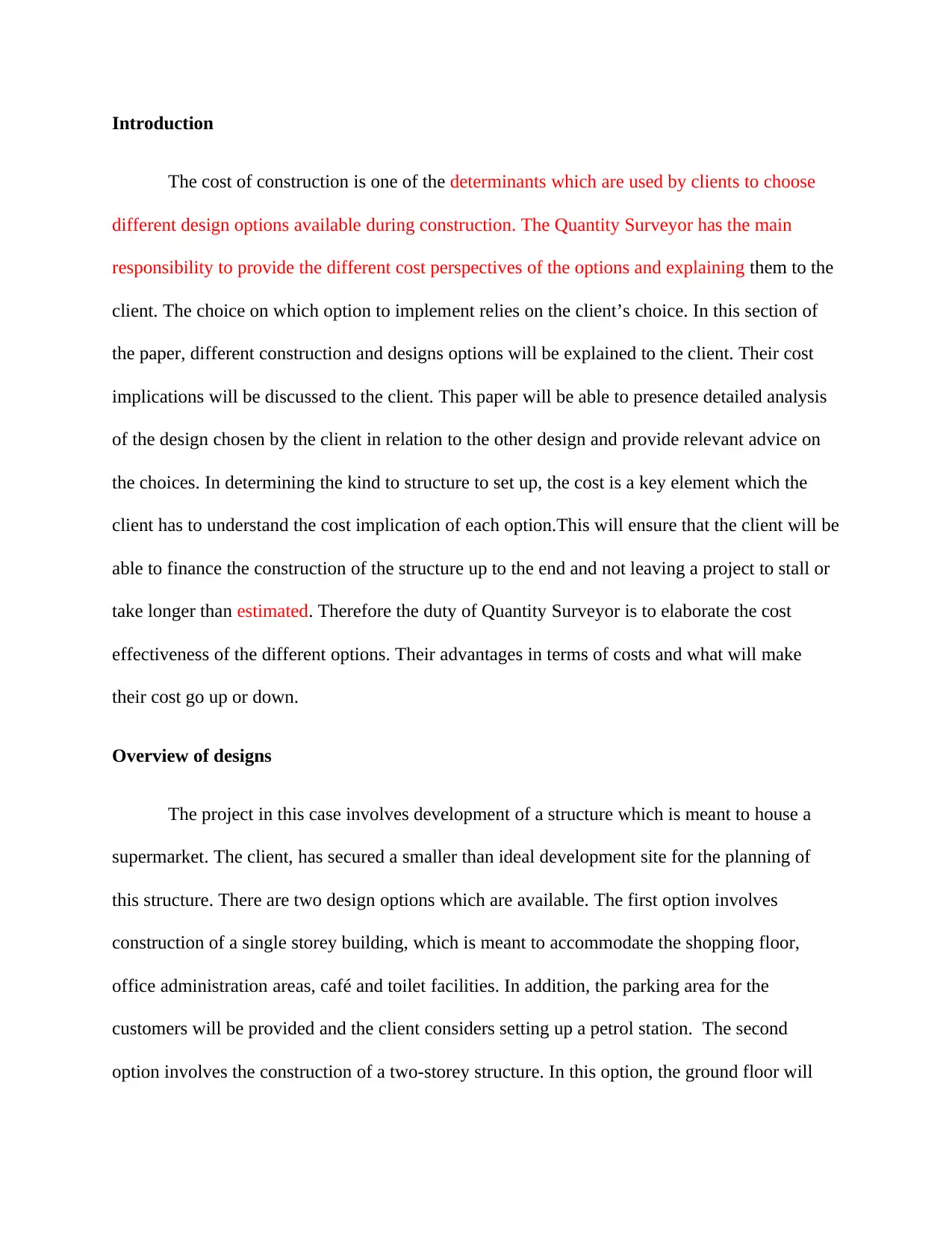
Introduction
The cost of construction is one of the determinants which are used by clients to choose
different design options available during construction. The Quantity Surveyor has the main
responsibility to provide the different cost perspectives of the options and explaining them to the
client. The choice on which option to implement relies on the client’s choice. In this section of
the paper, different construction and designs options will be explained to the client. Their cost
implications will be discussed to the client. This paper will be able to presence detailed analysis
of the design chosen by the client in relation to the other design and provide relevant advice on
the choices. In determining the kind to structure to set up, the cost is a key element which the
client has to understand the cost implication of each option.This will ensure that the client will be
able to finance the construction of the structure up to the end and not leaving a project to stall or
take longer than estimated. Therefore the duty of Quantity Surveyor is to elaborate the cost
effectiveness of the different options. Their advantages in terms of costs and what will make
their cost go up or down.
Overview of designs
The project in this case involves development of a structure which is meant to house a
supermarket. The client, has secured a smaller than ideal development site for the planning of
this structure. There are two design options which are available. The first option involves
construction of a single storey building, which is meant to accommodate the shopping floor,
office administration areas, café and toilet facilities. In addition, the parking area for the
customers will be provided and the client considers setting up a petrol station. The second
option involves the construction of a two-storey structure. In this option, the ground floor will
The cost of construction is one of the determinants which are used by clients to choose
different design options available during construction. The Quantity Surveyor has the main
responsibility to provide the different cost perspectives of the options and explaining them to the
client. The choice on which option to implement relies on the client’s choice. In this section of
the paper, different construction and designs options will be explained to the client. Their cost
implications will be discussed to the client. This paper will be able to presence detailed analysis
of the design chosen by the client in relation to the other design and provide relevant advice on
the choices. In determining the kind to structure to set up, the cost is a key element which the
client has to understand the cost implication of each option.This will ensure that the client will be
able to finance the construction of the structure up to the end and not leaving a project to stall or
take longer than estimated. Therefore the duty of Quantity Surveyor is to elaborate the cost
effectiveness of the different options. Their advantages in terms of costs and what will make
their cost go up or down.
Overview of designs
The project in this case involves development of a structure which is meant to house a
supermarket. The client, has secured a smaller than ideal development site for the planning of
this structure. There are two design options which are available. The first option involves
construction of a single storey building, which is meant to accommodate the shopping floor,
office administration areas, café and toilet facilities. In addition, the parking area for the
customers will be provided and the client considers setting up a petrol station. The second
option involves the construction of a two-storey structure. In this option, the ground floor will
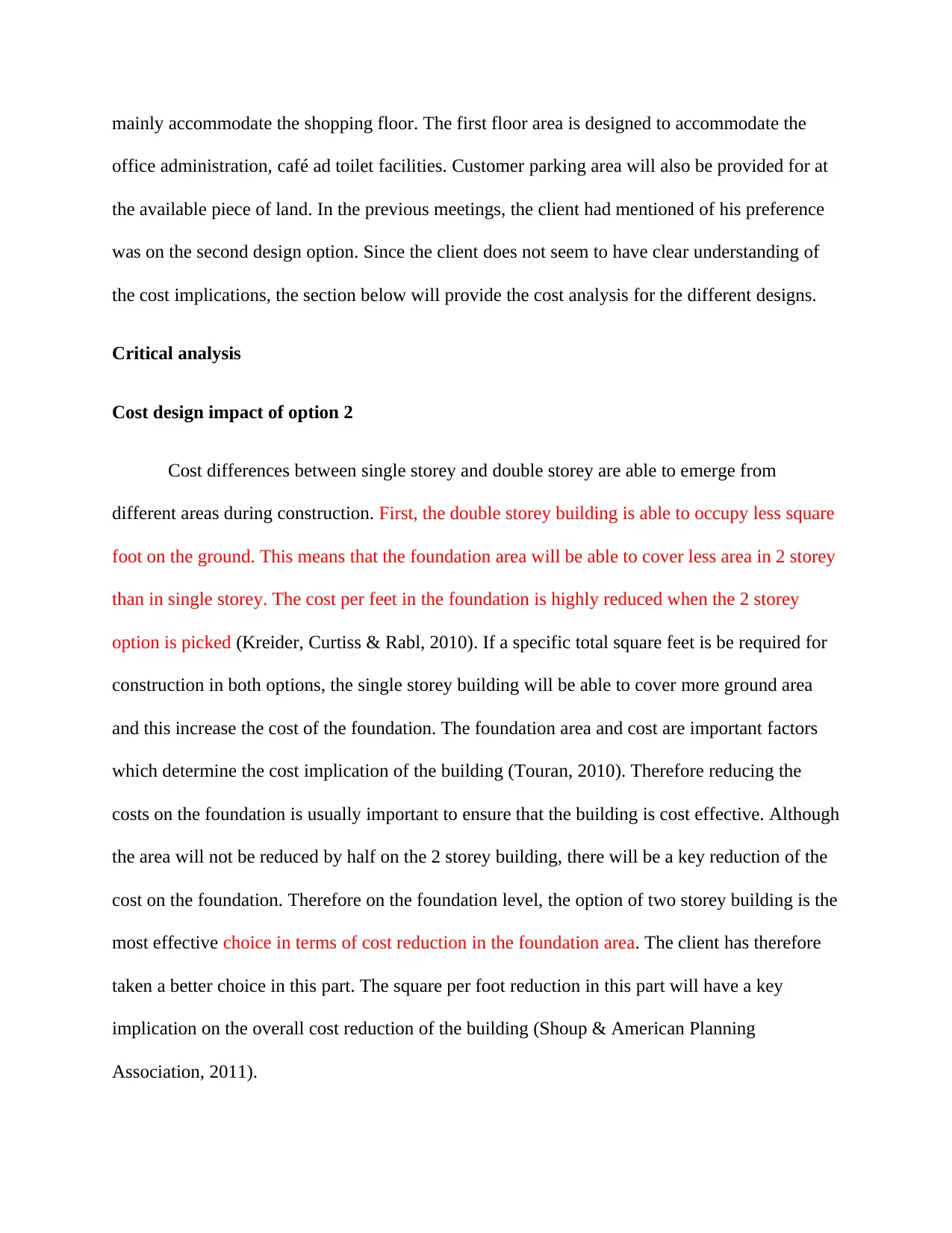
mainly accommodate the shopping floor. The first floor area is designed to accommodate the
office administration, café ad toilet facilities. Customer parking area will also be provided for at
the available piece of land. In the previous meetings, the client had mentioned of his preference
was on the second design option. Since the client does not seem to have clear understanding of
the cost implications, the section below will provide the cost analysis for the different designs.
Critical analysis
Cost design impact of option 2
Cost differences between single storey and double storey are able to emerge from
different areas during construction. First, the double storey building is able to occupy less square
foot on the ground. This means that the foundation area will be able to cover less area in 2 storey
than in single storey. The cost per feet in the foundation is highly reduced when the 2 storey
option is picked (Kreider, Curtiss & Rabl, 2010). If a specific total square feet is be required for
construction in both options, the single storey building will be able to cover more ground area
and this increase the cost of the foundation. The foundation area and cost are important factors
which determine the cost implication of the building (Touran, 2010). Therefore reducing the
costs on the foundation is usually important to ensure that the building is cost effective. Although
the area will not be reduced by half on the 2 storey building, there will be a key reduction of the
cost on the foundation. Therefore on the foundation level, the option of two storey building is the
most effective choice in terms of cost reduction in the foundation area. The client has therefore
taken a better choice in this part. The square per foot reduction in this part will have a key
implication on the overall cost reduction of the building (Shoup & American Planning
Association, 2011).
office administration, café ad toilet facilities. Customer parking area will also be provided for at
the available piece of land. In the previous meetings, the client had mentioned of his preference
was on the second design option. Since the client does not seem to have clear understanding of
the cost implications, the section below will provide the cost analysis for the different designs.
Critical analysis
Cost design impact of option 2
Cost differences between single storey and double storey are able to emerge from
different areas during construction. First, the double storey building is able to occupy less square
foot on the ground. This means that the foundation area will be able to cover less area in 2 storey
than in single storey. The cost per feet in the foundation is highly reduced when the 2 storey
option is picked (Kreider, Curtiss & Rabl, 2010). If a specific total square feet is be required for
construction in both options, the single storey building will be able to cover more ground area
and this increase the cost of the foundation. The foundation area and cost are important factors
which determine the cost implication of the building (Touran, 2010). Therefore reducing the
costs on the foundation is usually important to ensure that the building is cost effective. Although
the area will not be reduced by half on the 2 storey building, there will be a key reduction of the
cost on the foundation. Therefore on the foundation level, the option of two storey building is the
most effective choice in terms of cost reduction in the foundation area. The client has therefore
taken a better choice in this part. The square per foot reduction in this part will have a key
implication on the overall cost reduction of the building (Shoup & American Planning
Association, 2011).
⊘ This is a preview!⊘
Do you want full access?
Subscribe today to unlock all pages.

Trusted by 1+ million students worldwide
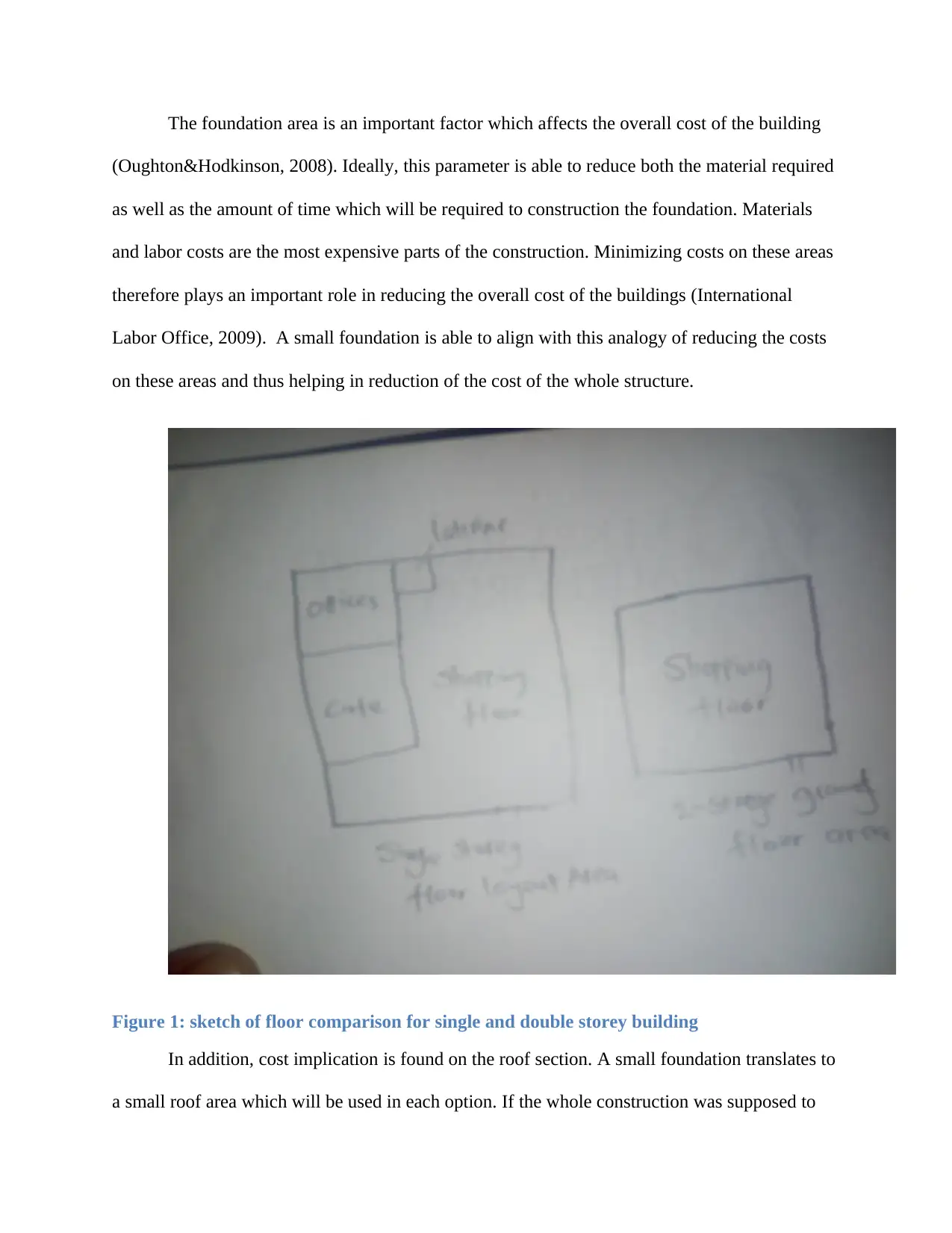
The foundation area is an important factor which affects the overall cost of the building
(Oughton&Hodkinson, 2008). Ideally, this parameter is able to reduce both the material required
as well as the amount of time which will be required to construction the foundation. Materials
and labor costs are the most expensive parts of the construction. Minimizing costs on these areas
therefore plays an important role in reducing the overall cost of the buildings (International
Labor Office, 2009). A small foundation is able to align with this analogy of reducing the costs
on these areas and thus helping in reduction of the cost of the whole structure.
Figure 1: sketch of floor comparison for single and double storey building
In addition, cost implication is found on the roof section. A small foundation translates to
a small roof area which will be used in each option. If the whole construction was supposed to
(Oughton&Hodkinson, 2008). Ideally, this parameter is able to reduce both the material required
as well as the amount of time which will be required to construction the foundation. Materials
and labor costs are the most expensive parts of the construction. Minimizing costs on these areas
therefore plays an important role in reducing the overall cost of the buildings (International
Labor Office, 2009). A small foundation is able to align with this analogy of reducing the costs
on these areas and thus helping in reduction of the cost of the whole structure.
Figure 1: sketch of floor comparison for single and double storey building
In addition, cost implication is found on the roof section. A small foundation translates to
a small roof area which will be used in each option. If the whole construction was supposed to
Paraphrase This Document
Need a fresh take? Get an instant paraphrase of this document with our AI Paraphraser
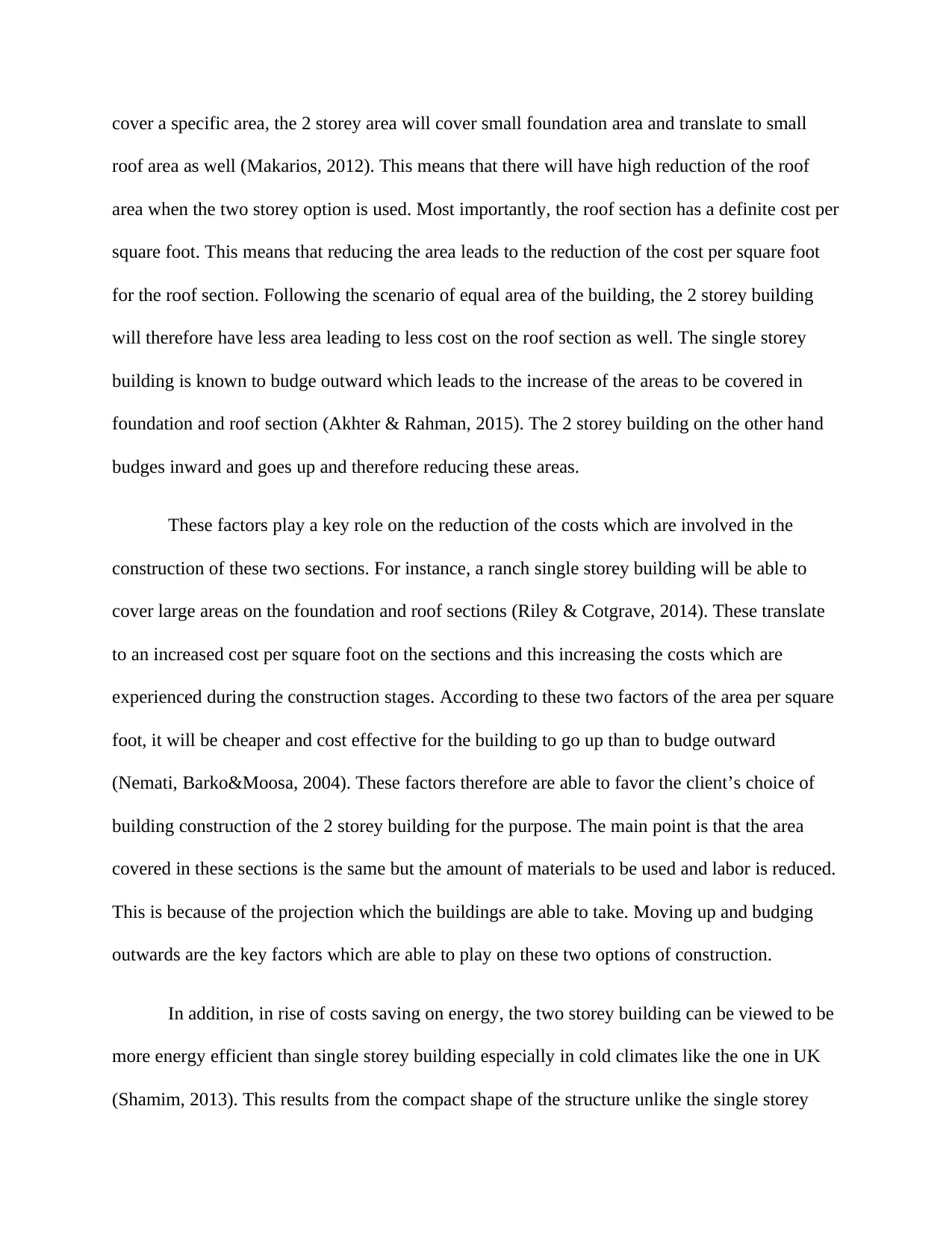
cover a specific area, the 2 storey area will cover small foundation area and translate to small
roof area as well (Makarios, 2012). This means that there will have high reduction of the roof
area when the two storey option is used. Most importantly, the roof section has a definite cost per
square foot. This means that reducing the area leads to the reduction of the cost per square foot
for the roof section. Following the scenario of equal area of the building, the 2 storey building
will therefore have less area leading to less cost on the roof section as well. The single storey
building is known to budge outward which leads to the increase of the areas to be covered in
foundation and roof section (Akhter & Rahman, 2015). The 2 storey building on the other hand
budges inward and goes up and therefore reducing these areas.
These factors play a key role on the reduction of the costs which are involved in the
construction of these two sections. For instance, a ranch single storey building will be able to
cover large areas on the foundation and roof sections (Riley & Cotgrave, 2014). These translate
to an increased cost per square foot on the sections and this increasing the costs which are
experienced during the construction stages. According to these two factors of the area per square
foot, it will be cheaper and cost effective for the building to go up than to budge outward
(Nemati, Barko&Moosa, 2004). These factors therefore are able to favor the client’s choice of
building construction of the 2 storey building for the purpose. The main point is that the area
covered in these sections is the same but the amount of materials to be used and labor is reduced.
This is because of the projection which the buildings are able to take. Moving up and budging
outwards are the key factors which are able to play on these two options of construction.
In addition, in rise of costs saving on energy, the two storey building can be viewed to be
more energy efficient than single storey building especially in cold climates like the one in UK
(Shamim, 2013). This results from the compact shape of the structure unlike the single storey
roof area as well (Makarios, 2012). This means that there will have high reduction of the roof
area when the two storey option is used. Most importantly, the roof section has a definite cost per
square foot. This means that reducing the area leads to the reduction of the cost per square foot
for the roof section. Following the scenario of equal area of the building, the 2 storey building
will therefore have less area leading to less cost on the roof section as well. The single storey
building is known to budge outward which leads to the increase of the areas to be covered in
foundation and roof section (Akhter & Rahman, 2015). The 2 storey building on the other hand
budges inward and goes up and therefore reducing these areas.
These factors play a key role on the reduction of the costs which are involved in the
construction of these two sections. For instance, a ranch single storey building will be able to
cover large areas on the foundation and roof sections (Riley & Cotgrave, 2014). These translate
to an increased cost per square foot on the sections and this increasing the costs which are
experienced during the construction stages. According to these two factors of the area per square
foot, it will be cheaper and cost effective for the building to go up than to budge outward
(Nemati, Barko&Moosa, 2004). These factors therefore are able to favor the client’s choice of
building construction of the 2 storey building for the purpose. The main point is that the area
covered in these sections is the same but the amount of materials to be used and labor is reduced.
This is because of the projection which the buildings are able to take. Moving up and budging
outwards are the key factors which are able to play on these two options of construction.
In addition, in rise of costs saving on energy, the two storey building can be viewed to be
more energy efficient than single storey building especially in cold climates like the one in UK
(Shamim, 2013). This results from the compact shape of the structure unlike the single storey
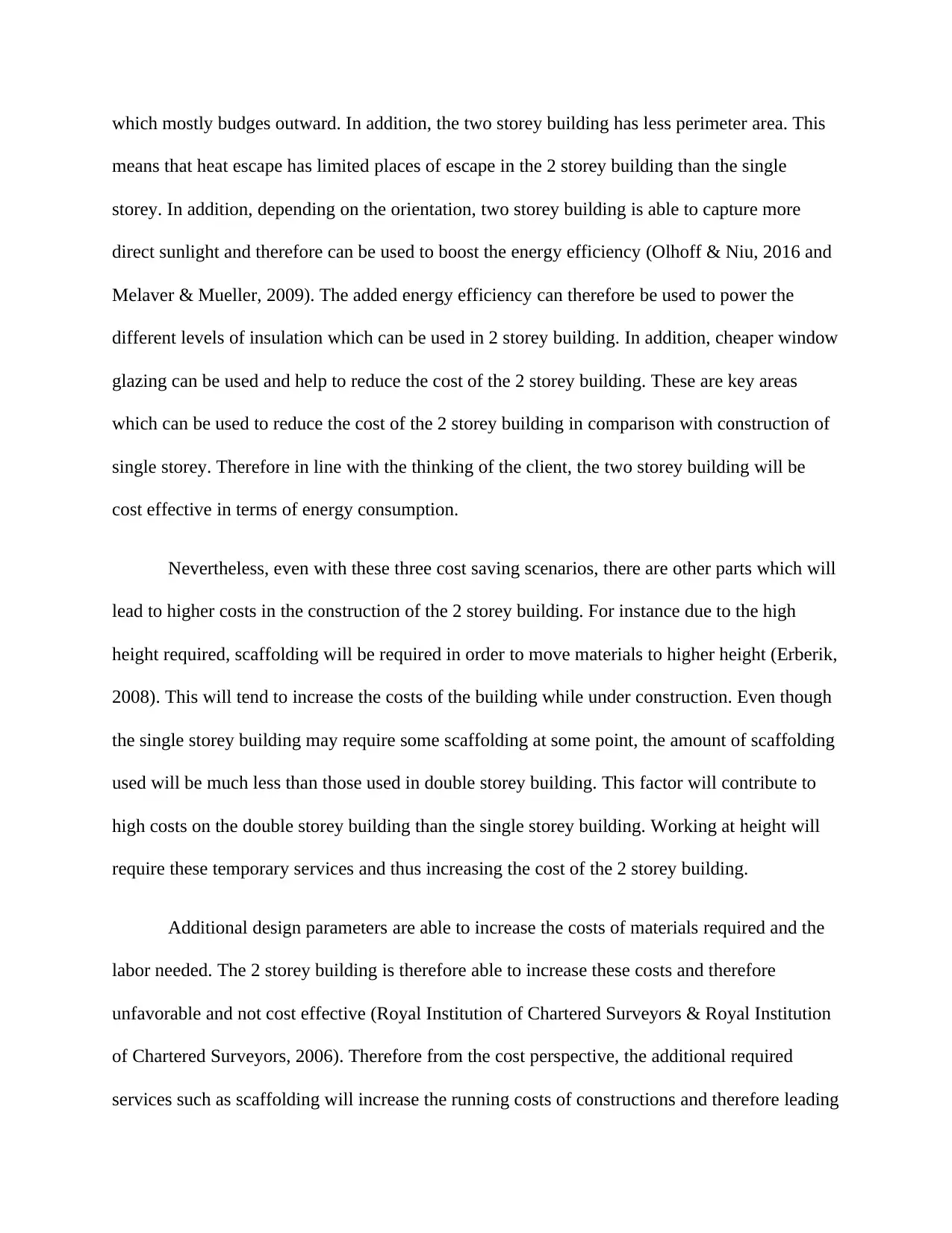
which mostly budges outward. In addition, the two storey building has less perimeter area. This
means that heat escape has limited places of escape in the 2 storey building than the single
storey. In addition, depending on the orientation, two storey building is able to capture more
direct sunlight and therefore can be used to boost the energy efficiency (Olhoff & Niu, 2016 and
Melaver & Mueller, 2009). The added energy efficiency can therefore be used to power the
different levels of insulation which can be used in 2 storey building. In addition, cheaper window
glazing can be used and help to reduce the cost of the 2 storey building. These are key areas
which can be used to reduce the cost of the 2 storey building in comparison with construction of
single storey. Therefore in line with the thinking of the client, the two storey building will be
cost effective in terms of energy consumption.
Nevertheless, even with these three cost saving scenarios, there are other parts which will
lead to higher costs in the construction of the 2 storey building. For instance due to the high
height required, scaffolding will be required in order to move materials to higher height (Erberik,
2008). This will tend to increase the costs of the building while under construction. Even though
the single storey building may require some scaffolding at some point, the amount of scaffolding
used will be much less than those used in double storey building. This factor will contribute to
high costs on the double storey building than the single storey building. Working at height will
require these temporary services and thus increasing the cost of the 2 storey building.
Additional design parameters are able to increase the costs of materials required and the
labor needed. The 2 storey building is therefore able to increase these costs and therefore
unfavorable and not cost effective (Royal Institution of Chartered Surveyors & Royal Institution
of Chartered Surveyors, 2006). Therefore from the cost perspective, the additional required
services such as scaffolding will increase the running costs of constructions and therefore leading
means that heat escape has limited places of escape in the 2 storey building than the single
storey. In addition, depending on the orientation, two storey building is able to capture more
direct sunlight and therefore can be used to boost the energy efficiency (Olhoff & Niu, 2016 and
Melaver & Mueller, 2009). The added energy efficiency can therefore be used to power the
different levels of insulation which can be used in 2 storey building. In addition, cheaper window
glazing can be used and help to reduce the cost of the 2 storey building. These are key areas
which can be used to reduce the cost of the 2 storey building in comparison with construction of
single storey. Therefore in line with the thinking of the client, the two storey building will be
cost effective in terms of energy consumption.
Nevertheless, even with these three cost saving scenarios, there are other parts which will
lead to higher costs in the construction of the 2 storey building. For instance due to the high
height required, scaffolding will be required in order to move materials to higher height (Erberik,
2008). This will tend to increase the costs of the building while under construction. Even though
the single storey building may require some scaffolding at some point, the amount of scaffolding
used will be much less than those used in double storey building. This factor will contribute to
high costs on the double storey building than the single storey building. Working at height will
require these temporary services and thus increasing the cost of the 2 storey building.
Additional design parameters are able to increase the costs of materials required and the
labor needed. The 2 storey building is therefore able to increase these costs and therefore
unfavorable and not cost effective (Royal Institution of Chartered Surveyors & Royal Institution
of Chartered Surveyors, 2006). Therefore from the cost perspective, the additional required
services such as scaffolding will increase the running costs of constructions and therefore leading
⊘ This is a preview!⊘
Do you want full access?
Subscribe today to unlock all pages.

Trusted by 1+ million students worldwide
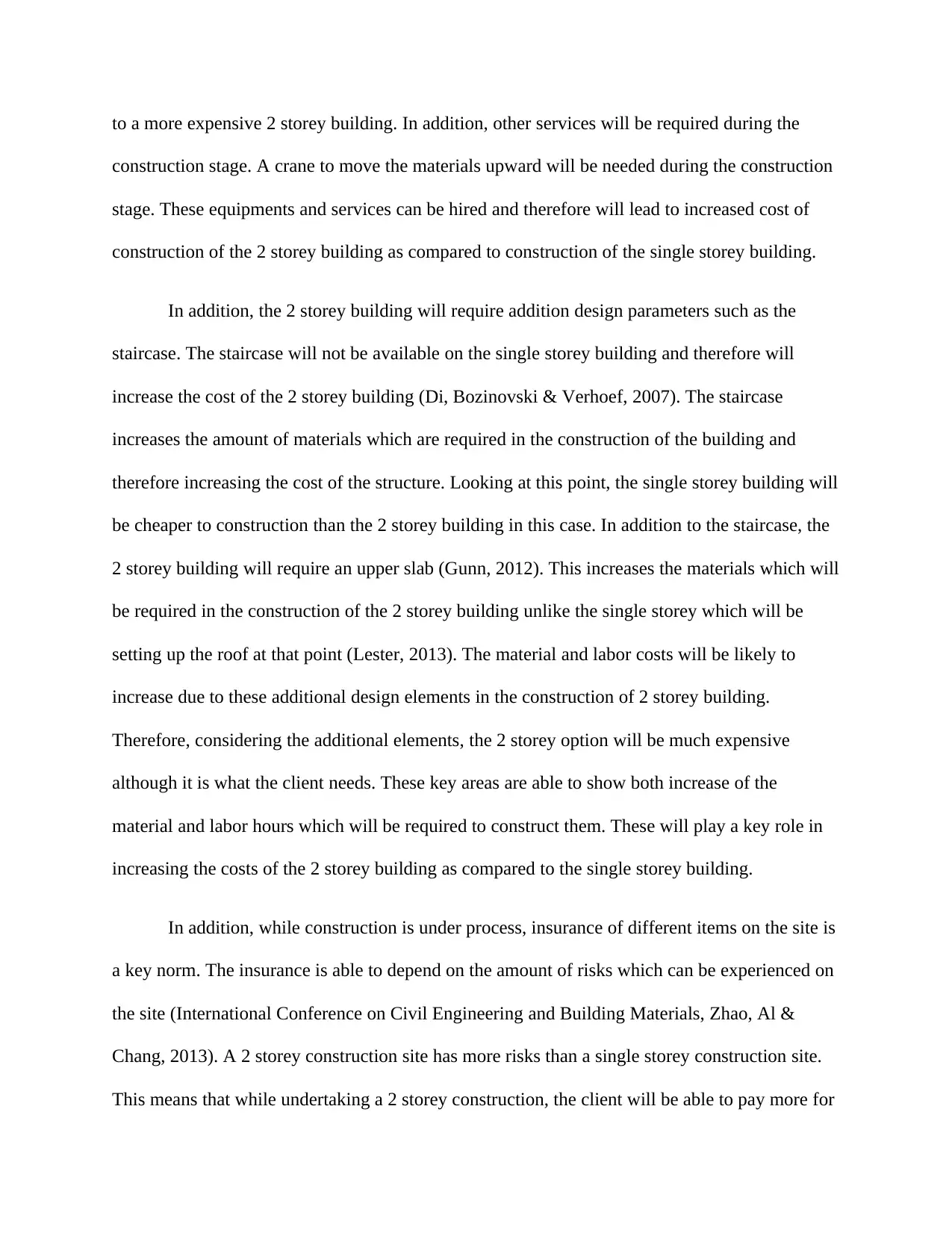
to a more expensive 2 storey building. In addition, other services will be required during the
construction stage. A crane to move the materials upward will be needed during the construction
stage. These equipments and services can be hired and therefore will lead to increased cost of
construction of the 2 storey building as compared to construction of the single storey building.
In addition, the 2 storey building will require addition design parameters such as the
staircase. The staircase will not be available on the single storey building and therefore will
increase the cost of the 2 storey building (Di, Bozinovski & Verhoef, 2007). The staircase
increases the amount of materials which are required in the construction of the building and
therefore increasing the cost of the structure. Looking at this point, the single storey building will
be cheaper to construction than the 2 storey building in this case. In addition to the staircase, the
2 storey building will require an upper slab (Gunn, 2012). This increases the materials which will
be required in the construction of the 2 storey building unlike the single storey which will be
setting up the roof at that point (Lester, 2013). The material and labor costs will be likely to
increase due to these additional design elements in the construction of 2 storey building.
Therefore, considering the additional elements, the 2 storey option will be much expensive
although it is what the client needs. These key areas are able to show both increase of the
material and labor hours which will be required to construct them. These will play a key role in
increasing the costs of the 2 storey building as compared to the single storey building.
In addition, while construction is under process, insurance of different items on the site is
a key norm. The insurance is able to depend on the amount of risks which can be experienced on
the site (International Conference on Civil Engineering and Building Materials, Zhao, Al &
Chang, 2013). A 2 storey construction site has more risks than a single storey construction site.
This means that while undertaking a 2 storey construction, the client will be able to pay more for
construction stage. A crane to move the materials upward will be needed during the construction
stage. These equipments and services can be hired and therefore will lead to increased cost of
construction of the 2 storey building as compared to construction of the single storey building.
In addition, the 2 storey building will require addition design parameters such as the
staircase. The staircase will not be available on the single storey building and therefore will
increase the cost of the 2 storey building (Di, Bozinovski & Verhoef, 2007). The staircase
increases the amount of materials which are required in the construction of the building and
therefore increasing the cost of the structure. Looking at this point, the single storey building will
be cheaper to construction than the 2 storey building in this case. In addition to the staircase, the
2 storey building will require an upper slab (Gunn, 2012). This increases the materials which will
be required in the construction of the 2 storey building unlike the single storey which will be
setting up the roof at that point (Lester, 2013). The material and labor costs will be likely to
increase due to these additional design elements in the construction of 2 storey building.
Therefore, considering the additional elements, the 2 storey option will be much expensive
although it is what the client needs. These key areas are able to show both increase of the
material and labor hours which will be required to construct them. These will play a key role in
increasing the costs of the 2 storey building as compared to the single storey building.
In addition, while construction is under process, insurance of different items on the site is
a key norm. The insurance is able to depend on the amount of risks which can be experienced on
the site (International Conference on Civil Engineering and Building Materials, Zhao, Al &
Chang, 2013). A 2 storey construction site has more risks than a single storey construction site.
This means that while undertaking a 2 storey construction, the client will be able to pay more for
Paraphrase This Document
Need a fresh take? Get an instant paraphrase of this document with our AI Paraphraser
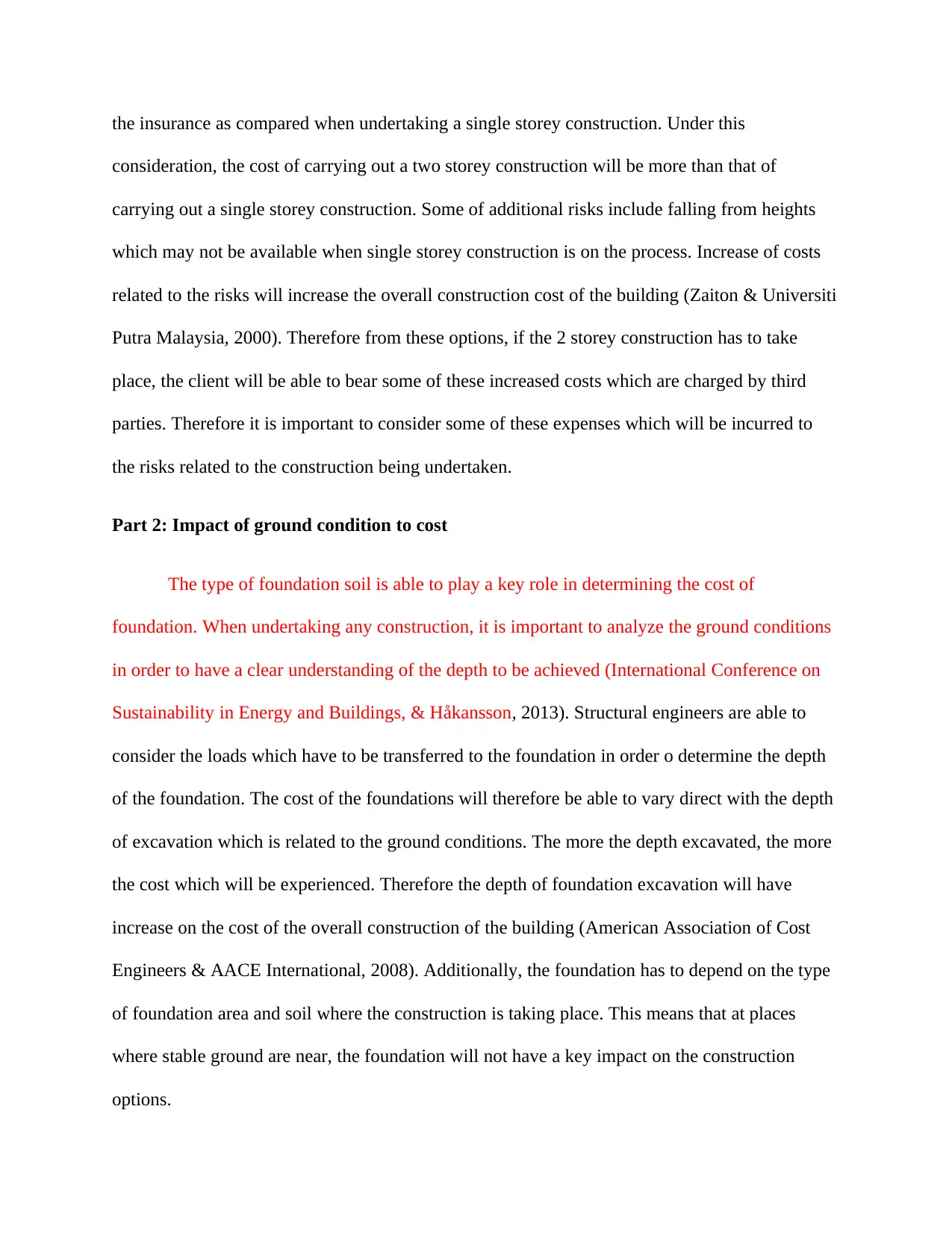
the insurance as compared when undertaking a single storey construction. Under this
consideration, the cost of carrying out a two storey construction will be more than that of
carrying out a single storey construction. Some of additional risks include falling from heights
which may not be available when single storey construction is on the process. Increase of costs
related to the risks will increase the overall construction cost of the building (Zaiton & Universiti
Putra Malaysia, 2000). Therefore from these options, if the 2 storey construction has to take
place, the client will be able to bear some of these increased costs which are charged by third
parties. Therefore it is important to consider some of these expenses which will be incurred to
the risks related to the construction being undertaken.
Part 2: Impact of ground condition to cost
The type of foundation soil is able to play a key role in determining the cost of
foundation. When undertaking any construction, it is important to analyze the ground conditions
in order to have a clear understanding of the depth to be achieved (International Conference on
Sustainability in Energy and Buildings, & Håkansson , 2013). Structural engineers are able to
consider the loads which have to be transferred to the foundation in order o determine the depth
of the foundation. The cost of the foundations will therefore be able to vary direct with the depth
of excavation which is related to the ground conditions. The more the depth excavated, the more
the cost which will be experienced. Therefore the depth of foundation excavation will have
increase on the cost of the overall construction of the building (American Association of Cost
Engineers & AACE International, 2008). Additionally, the foundation has to depend on the type
of foundation area and soil where the construction is taking place. This means that at places
where stable ground are near, the foundation will not have a key impact on the construction
options.
consideration, the cost of carrying out a two storey construction will be more than that of
carrying out a single storey construction. Some of additional risks include falling from heights
which may not be available when single storey construction is on the process. Increase of costs
related to the risks will increase the overall construction cost of the building (Zaiton & Universiti
Putra Malaysia, 2000). Therefore from these options, if the 2 storey construction has to take
place, the client will be able to bear some of these increased costs which are charged by third
parties. Therefore it is important to consider some of these expenses which will be incurred to
the risks related to the construction being undertaken.
Part 2: Impact of ground condition to cost
The type of foundation soil is able to play a key role in determining the cost of
foundation. When undertaking any construction, it is important to analyze the ground conditions
in order to have a clear understanding of the depth to be achieved (International Conference on
Sustainability in Energy and Buildings, & Håkansson , 2013). Structural engineers are able to
consider the loads which have to be transferred to the foundation in order o determine the depth
of the foundation. The cost of the foundations will therefore be able to vary direct with the depth
of excavation which is related to the ground conditions. The more the depth excavated, the more
the cost which will be experienced. Therefore the depth of foundation excavation will have
increase on the cost of the overall construction of the building (American Association of Cost
Engineers & AACE International, 2008). Additionally, the foundation has to depend on the type
of foundation area and soil where the construction is taking place. This means that at places
where stable ground are near, the foundation will not have a key impact on the construction
options.
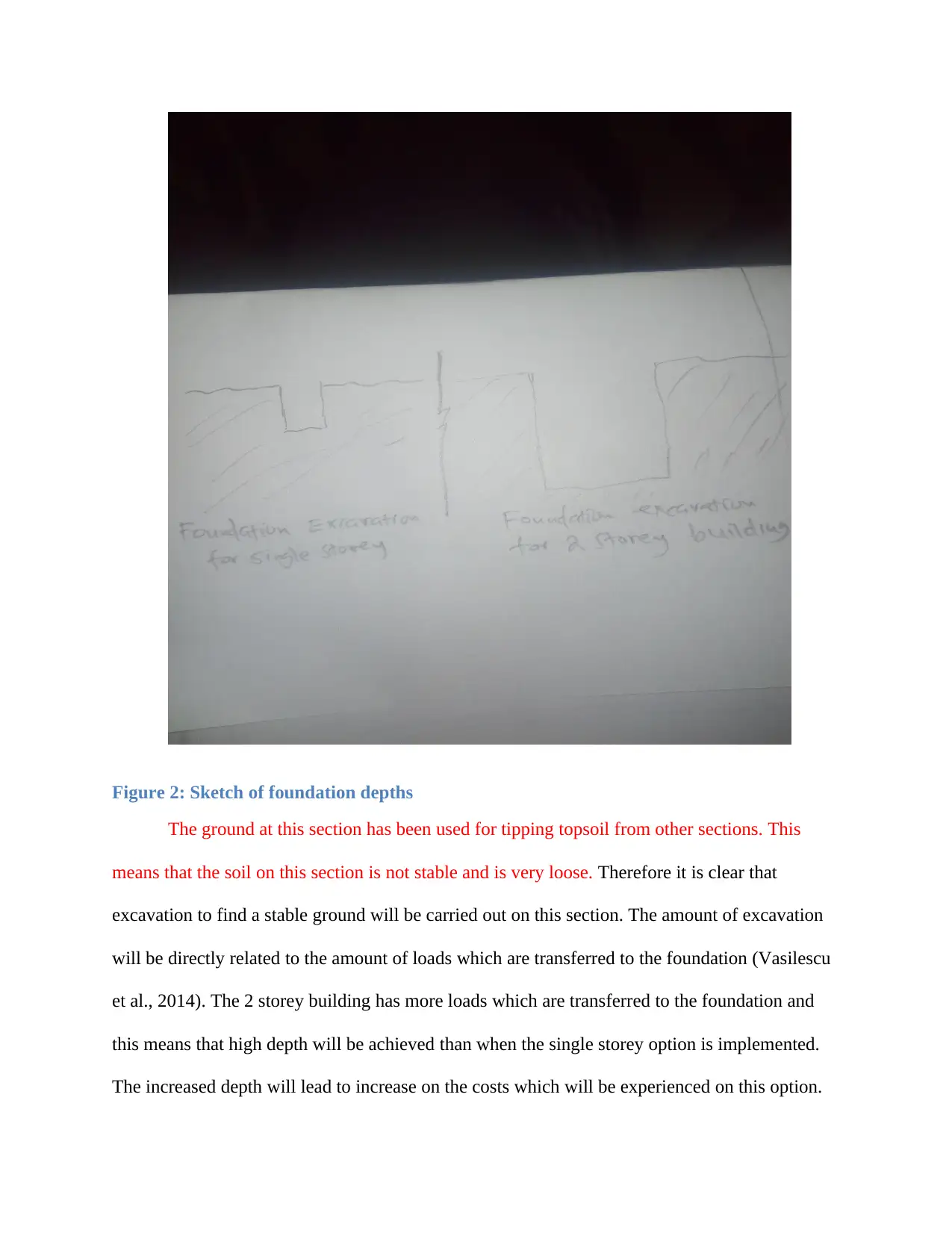
Figure 2: Sketch of foundation depths
The ground at this section has been used for tipping topsoil from other sections. This
means that the soil on this section is not stable and is very loose. Therefore it is clear that
excavation to find a stable ground will be carried out on this section. The amount of excavation
will be directly related to the amount of loads which are transferred to the foundation (Vasilescu
et al., 2014). The 2 storey building has more loads which are transferred to the foundation and
this means that high depth will be achieved than when the single storey option is implemented.
The increased depth will lead to increase on the costs which will be experienced on this option.
The ground at this section has been used for tipping topsoil from other sections. This
means that the soil on this section is not stable and is very loose. Therefore it is clear that
excavation to find a stable ground will be carried out on this section. The amount of excavation
will be directly related to the amount of loads which are transferred to the foundation (Vasilescu
et al., 2014). The 2 storey building has more loads which are transferred to the foundation and
this means that high depth will be achieved than when the single storey option is implemented.
The increased depth will lead to increase on the costs which will be experienced on this option.
⊘ This is a preview!⊘
Do you want full access?
Subscribe today to unlock all pages.

Trusted by 1+ million students worldwide
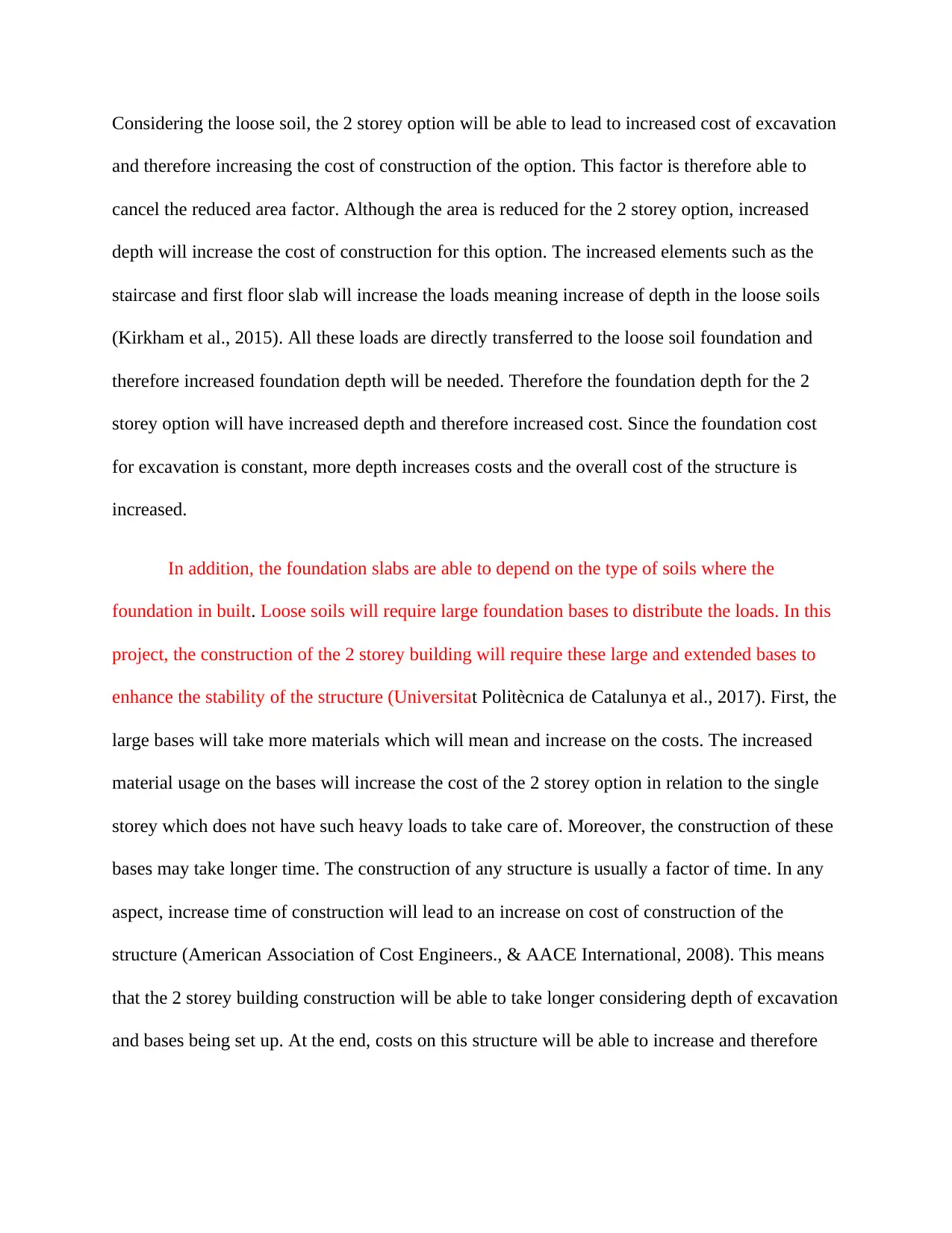
Considering the loose soil, the 2 storey option will be able to lead to increased cost of excavation
and therefore increasing the cost of construction of the option. This factor is therefore able to
cancel the reduced area factor. Although the area is reduced for the 2 storey option, increased
depth will increase the cost of construction for this option. The increased elements such as the
staircase and first floor slab will increase the loads meaning increase of depth in the loose soils
(Kirkham et al., 2015). All these loads are directly transferred to the loose soil foundation and
therefore increased foundation depth will be needed. Therefore the foundation depth for the 2
storey option will have increased depth and therefore increased cost. Since the foundation cost
for excavation is constant, more depth increases costs and the overall cost of the structure is
increased.
In addition, the foundation slabs are able to depend on the type of soils where the
foundation in built. Loose soils will require large foundation bases to distribute the loads. In this
project, the construction of the 2 storey building will require these large and extended bases to
enhance the stability of the structure (Universitat Politècnica de Catalunya et al., 2017). First, the
large bases will take more materials which will mean and increase on the costs. The increased
material usage on the bases will increase the cost of the 2 storey option in relation to the single
storey which does not have such heavy loads to take care of. Moreover, the construction of these
bases may take longer time. The construction of any structure is usually a factor of time. In any
aspect, increase time of construction will lead to an increase on cost of construction of the
structure (American Association of Cost Engineers., & AACE International, 2008). This means
that the 2 storey building construction will be able to take longer considering depth of excavation
and bases being set up. At the end, costs on this structure will be able to increase and therefore
and therefore increasing the cost of construction of the option. This factor is therefore able to
cancel the reduced area factor. Although the area is reduced for the 2 storey option, increased
depth will increase the cost of construction for this option. The increased elements such as the
staircase and first floor slab will increase the loads meaning increase of depth in the loose soils
(Kirkham et al., 2015). All these loads are directly transferred to the loose soil foundation and
therefore increased foundation depth will be needed. Therefore the foundation depth for the 2
storey option will have increased depth and therefore increased cost. Since the foundation cost
for excavation is constant, more depth increases costs and the overall cost of the structure is
increased.
In addition, the foundation slabs are able to depend on the type of soils where the
foundation in built. Loose soils will require large foundation bases to distribute the loads. In this
project, the construction of the 2 storey building will require these large and extended bases to
enhance the stability of the structure (Universitat Politècnica de Catalunya et al., 2017). First, the
large bases will take more materials which will mean and increase on the costs. The increased
material usage on the bases will increase the cost of the 2 storey option in relation to the single
storey which does not have such heavy loads to take care of. Moreover, the construction of these
bases may take longer time. The construction of any structure is usually a factor of time. In any
aspect, increase time of construction will lead to an increase on cost of construction of the
structure (American Association of Cost Engineers., & AACE International, 2008). This means
that the 2 storey building construction will be able to take longer considering depth of excavation
and bases being set up. At the end, costs on this structure will be able to increase and therefore
Paraphrase This Document
Need a fresh take? Get an instant paraphrase of this document with our AI Paraphraser
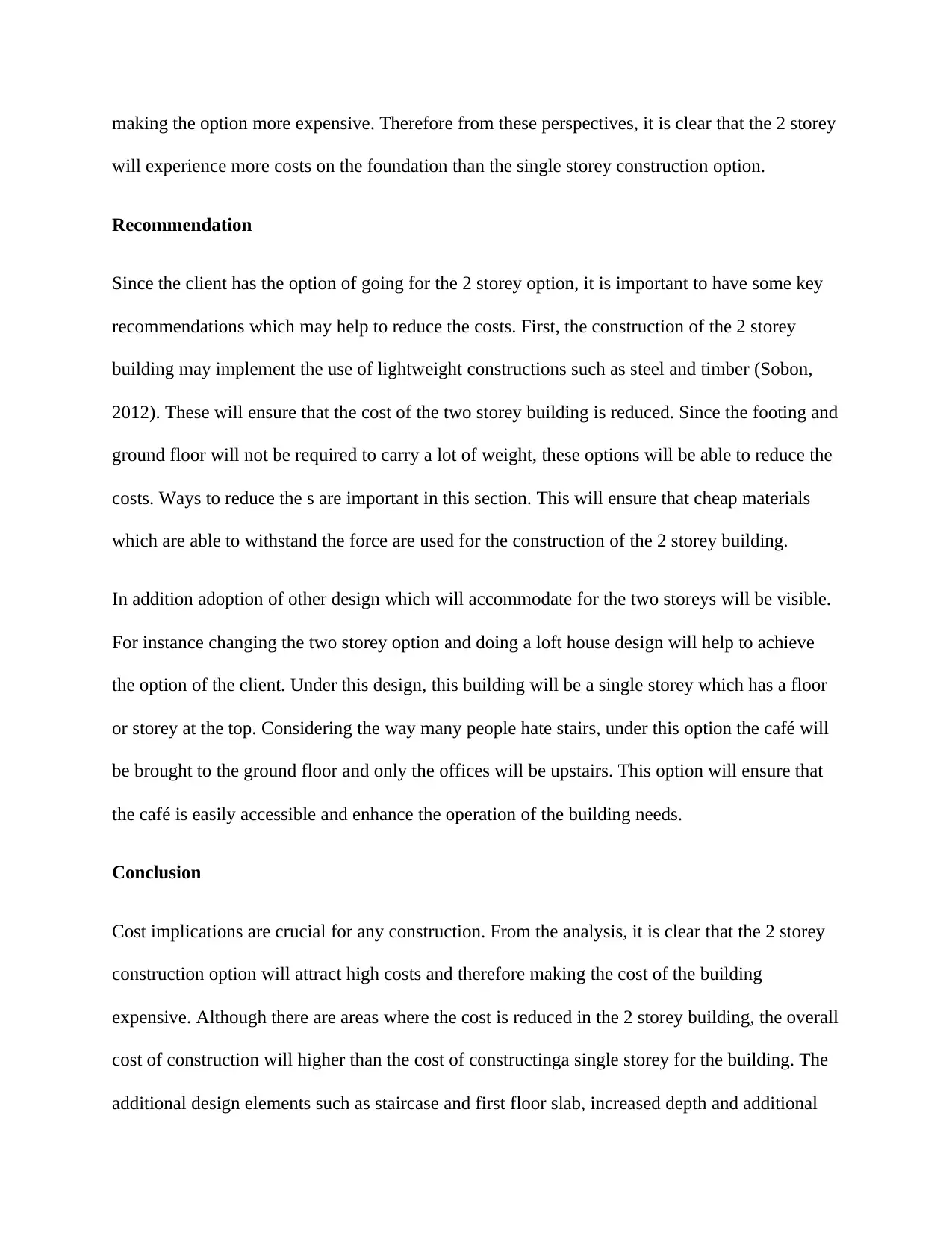
making the option more expensive. Therefore from these perspectives, it is clear that the 2 storey
will experience more costs on the foundation than the single storey construction option.
Recommendation
Since the client has the option of going for the 2 storey option, it is important to have some key
recommendations which may help to reduce the costs. First, the construction of the 2 storey
building may implement the use of lightweight constructions such as steel and timber (Sobon,
2012). These will ensure that the cost of the two storey building is reduced. Since the footing and
ground floor will not be required to carry a lot of weight, these options will be able to reduce the
costs. Ways to reduce the s are important in this section. This will ensure that cheap materials
which are able to withstand the force are used for the construction of the 2 storey building.
In addition adoption of other design which will accommodate for the two storeys will be visible.
For instance changing the two storey option and doing a loft house design will help to achieve
the option of the client. Under this design, this building will be a single storey which has a floor
or storey at the top. Considering the way many people hate stairs, under this option the café will
be brought to the ground floor and only the offices will be upstairs. This option will ensure that
the café is easily accessible and enhance the operation of the building needs.
Conclusion
Cost implications are crucial for any construction. From the analysis, it is clear that the 2 storey
construction option will attract high costs and therefore making the cost of the building
expensive. Although there are areas where the cost is reduced in the 2 storey building, the overall
cost of construction will higher than the cost of constructinga single storey for the building. The
additional design elements such as staircase and first floor slab, increased depth and additional
will experience more costs on the foundation than the single storey construction option.
Recommendation
Since the client has the option of going for the 2 storey option, it is important to have some key
recommendations which may help to reduce the costs. First, the construction of the 2 storey
building may implement the use of lightweight constructions such as steel and timber (Sobon,
2012). These will ensure that the cost of the two storey building is reduced. Since the footing and
ground floor will not be required to carry a lot of weight, these options will be able to reduce the
costs. Ways to reduce the s are important in this section. This will ensure that cheap materials
which are able to withstand the force are used for the construction of the 2 storey building.
In addition adoption of other design which will accommodate for the two storeys will be visible.
For instance changing the two storey option and doing a loft house design will help to achieve
the option of the client. Under this design, this building will be a single storey which has a floor
or storey at the top. Considering the way many people hate stairs, under this option the café will
be brought to the ground floor and only the offices will be upstairs. This option will ensure that
the café is easily accessible and enhance the operation of the building needs.
Conclusion
Cost implications are crucial for any construction. From the analysis, it is clear that the 2 storey
construction option will attract high costs and therefore making the cost of the building
expensive. Although there are areas where the cost is reduced in the 2 storey building, the overall
cost of construction will higher than the cost of constructinga single storey for the building. The
additional design elements such as staircase and first floor slab, increased depth and additional
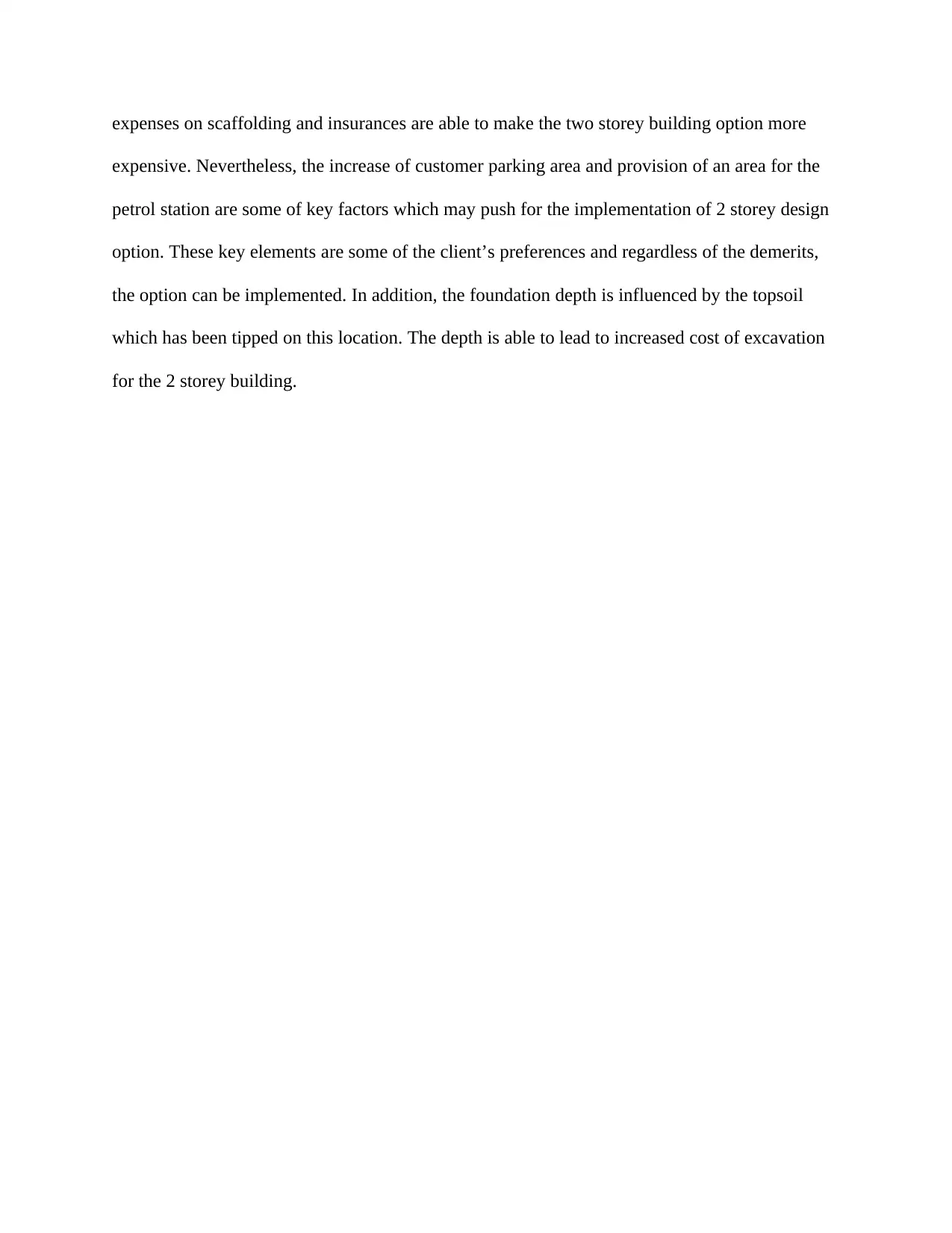
expenses on scaffolding and insurances are able to make the two storey building option more
expensive. Nevertheless, the increase of customer parking area and provision of an area for the
petrol station are some of key factors which may push for the implementation of 2 storey design
option. These key elements are some of the client’s preferences and regardless of the demerits,
the option can be implemented. In addition, the foundation depth is influenced by the topsoil
which has been tipped on this location. The depth is able to lead to increased cost of excavation
for the 2 storey building.
expensive. Nevertheless, the increase of customer parking area and provision of an area for the
petrol station are some of key factors which may push for the implementation of 2 storey design
option. These key elements are some of the client’s preferences and regardless of the demerits,
the option can be implemented. In addition, the foundation depth is influenced by the topsoil
which has been tipped on this location. The depth is able to lead to increased cost of excavation
for the 2 storey building.
⊘ This is a preview!⊘
Do you want full access?
Subscribe today to unlock all pages.

Trusted by 1+ million students worldwide
1 out of 16
Your All-in-One AI-Powered Toolkit for Academic Success.
+13062052269
info@desklib.com
Available 24*7 on WhatsApp / Email
![[object Object]](/_next/static/media/star-bottom.7253800d.svg)
Unlock your academic potential
Copyright © 2020–2025 A2Z Services. All Rights Reserved. Developed and managed by ZUCOL.

